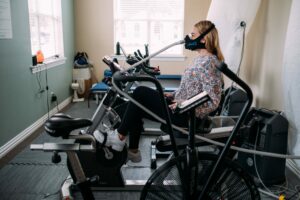What is Exercise With Oxygen Therapy (EWOT)?
What is Exercise with Oxygen Therapy (EWOT)?
Exercise with Oxygen Therapy (EWOT) involves performing physical exercise while breathing in concentrated oxygen, typically through a mask connected to an oxygen concentrator. The oxygen concentration provided during EWOT ranges between 94% to 98%, significantly higher than the 21% found in normal atmospheric air. This concentrated oxygen intake, combined with exercise, enhances the delivery of oxygen to the bloodstream, helping to support the body’s energy production and recovery processes.
During EWOT, increasing the heart rate is critical because it drives oxygen-rich blood more efficiently to organs and tissues that often struggle to receive adequate oxygen. These tissues typically receive enough oxygen to survive but not enough to fully engage in their energy cycles, which are necessary for proper cell turnover and regeneration.
- Apoptosis and Cellular Repair: With insufficient oxygen, tissues may not be able to undergo apoptosis (programmed cell death) when cells need to be replaced or repair themselves when damaged. This lack of oxygen can result in stagnation of tissue function, preventing proper healing or regeneration.
- Waste Accumulation and Detoxification: When tissues are oxygen-deprived, waste metabolites, such as toxins, carbon dioxide, and lactic acid, accumulate both inside the cells and in the surrounding tissue. These cells struggle to detoxify properly, leading to higher concentrations of waste products, inflammation, and impaired tissue health.
By breathing in 92% to 97% oxygen during exercise, EWOT helps saturate tissues with much-needed oxygen, promoting proper energy production, tissue regeneration, and the elimination of metabolic waste. This combination improves cellular function, helps repair damaged tissues, and restores balance in areas that were previously deprived of oxygen. (EWOT Energy) (PhysMedColumbus)

Benefits of Exercise with Oxygen Therapy (EWOT)
- Enhanced Energy Levels: EWOT increases the efficiency and speed of ATP (adenosine triphosphate) production, the energy currency of cells, by ensuring that adequate oxygen is supplied during exercise. With more oxygen available, cells can produce energy faster, reducing delays in energy production. In addition, the process of apoptosis (programmed cell death) is supported, removing old or inefficient cells from the system, which improves overall energy efficiency. This energy boost benefits not only those with chronic fatigue, chronic illness, and age-related decline but also people experiencing intermittent fatigue. For example, women may experience fatigue at different phases of their menstrual cycle, and athletes or individuals recovering from intense physical events—or even a late night out—can benefit from the improved energy levels provided by EWOT. (Dr. David Schiller) (One Thousand Roads).
- Improved Circulation: EWOT boosts nitric oxide production, a compound that plays a key role in vasodilation, the widening of blood vessels. This enhanced vasodilation allows oxygen-rich blood to flow more efficiently through capillaries and into tissues. As oxygen is pushed through the capillaries at an elevated rate during exercise, it helps open up small blood vessels and improves blood flow overall. This increased circulation can lead to a reduction in blood pressure and improved blood flow to extremities, which is particularly beneficial for patients with circulation issues or cardiovascular conditions. Enhanced circulation also accelerates recovery from injury by promoting better delivery of nutrients and oxygen to damaged tissues.
- Increased Endurance and Performance: For athletes and patients undergoing rehabilitation, EWOT significantly enhances endurance and performance. The higher oxygen levels during exercise allow muscles to work harder for longer periods without fatiguing. This translates into shorter recovery times, as the body can clear metabolic waste more effectively and repair tissue faster. Patients report less fatigue following exercise and experience quicker overall recovery, making EWOT a valuable tool in athletic training and post-injury rehabilitation.
- Detoxification: Breathing concentrated oxygen during exercise helps the body rapidly clear out metabolic waste products such as lactic acid and carbon dioxide. These waste products can build up during intense physical activity, leading to muscle soreness, fatigue, and inflammation. By accelerating their removal, EWOT helps alleviate these symptoms and supports overall detoxification processes in the body. In addition, better detoxification reduces the risk of toxin buildup, which can contribute to chronic inflammation, poor immune function, and a variety of other health issues.
- Anti-Inflammatory Benefits: EWOT’s ability to deliver more oxygen to tissues plays a key role in reducing inflammation. Oxygen helps to lower the levels of inflammatory markers in the body, which can be particularly beneficial for patients with inflammatory conditions such as arthritis. Many patients experience a noticeable decrease in joint pain, improved mobility, and a reduction in overall inflammation with regular EWOT sessions. The anti-inflammatory effects of increased oxygenation are especially valuable in managing chronic pain and autoimmune conditions.
- Enhanced Immune Function: EWOT has a profound effect on the immune system, particularly through the stimulation of T-lymphocyte production and natural killer (NK) cells, which are essential for fighting infections. Over the course of 8 weeks, patients typically see a significant increase in these immune cells, strengthening the body’s ability to combat viruses, bacteria, and other pathogens. EWOT is especially beneficial for patients suffering from chronic infections and those with conditions where low immunity is a major factor in keeping them ill or delaying their recovery. The improved oxygen supply helps the immune system function more effectively, promoting faster recovery and better.
Conditions That Benefit from EWOT
- Chronic Obstructive Pulmonary Disease (COPD) and Respiratory Disorders: EWOT provides similar benefits to Hyperbaric Oxygen Therapy (HBOT) in helping people with COPD. By delivering concentrated oxygen during exercise, EWOT helps improve both short- and long-term lung function. In the short term, patients may experience immediate relief in symptoms such as shortness of breath, improved oxygen saturation, and enhanced lung capacity. Over time, as the lungs are exposed to higher oxygen levels and stimulated through exercise, the therapy can promote lung repair and increase overall respiratory efficiency.
- Cardiovascular Diseases (e.g., Hypertension, Heart Disease): EWOT helps reduce strain on the heart by increasing vasodilation, which relaxes blood vessels and improves blood flow. This reduces the workload on the heart, particularly following therapy when the cardiovascular system is more efficient. Over time, this improved oxygenation leads to better cardiac function, helping to lower blood pressure and reduce the risk of heart disease. Regular use of EWOT may also improve circulation, particularly in the extremities, and enhance the heart’s ability to pump blood effectively.
- Chronic Fatigue Syndrome and Low Energy Levels: Patients with chronic fatigue syndrome often experience improvements in energy levels and mental clarity with EWOT. For those with chronic fatigue, EWOT may take longer to produce results as it works to repair damaged cells and detoxify the body over time. However, in cases of acute fatigue, such as fatigue following a stressful event, EWOT can deliver almost immediate improvements in energy. This combination of short-term relief and long-term benefits makes it a valuable therapy for patients experiencing both chronic and intermittent bouts of low energy.
- Autoimmune Disorders (e.g., Rheumatoid Arthritis): Improved oxygenation helps the immune system better target pathogens and reduces autoimmune responses that attack the body’s own tissues. This is likely due to the detoxifying properties of EWOT, which reduces the toxic load on the immune system, allowing it to function more efficiently. Autoimmune conditions that involve joint pain, such as rheumatoid arthritis, and disorders like fibromyalgia tend to respond particularly well to EWOT, as the therapy helps reduce inflammation and pain in affected areas.
- Fibromyalgia: For patients with fibromyalgia, EWOT significantly reduces pain levels and tenderness throughout the body. Improved oxygenation allows for better cellular repair and detoxification, which alleviates some of the key symptoms of the condition. In addition to pain relief, many patients report increased energy levels and improvements in cognitive function, such as reduced brain fog.
- Neurological Conditions (e.g., Multiple Sclerosis): EWOT benefits patients with neurological disorders such as Multiple Sclerosis (MS) by increasing oxygen supply to damaged nerve cells. Since MS is an autoimmune disorder, the same detoxification and immune-boosting effects seen in other autoimmune conditions are also at play here. Additionally, in patients with other types of neuropathy, EWOT enhances blood flow to extremities and supports cardiovascular health, promoting faster nerve healing. As nerves are slow healers, the increased blood flow and oxygenation help improve symptoms like mobility, fatigue, and cognitive function.
- Inflammatory Conditions (e.g., Arthritis): EWOT helps reduce inflammation by increasing oxygenation in the joints, detoxifying cells and blood, and enhancing cardiovascular fitness. This leads to better joint mobility, reduced pain, and improved overall joint health. The removal of toxins and increased oxygen supply to inflamed tissues allow the body to heal faster and maintain healthier joints.
- Diabetes and Insulin Resistance: EWOT helps manage blood sugar levels by making exercise easier and more efficient. Patients with diabetes often struggle with physical activity, but the increased oxygenation in EWOT allows them to exercise at a higher intensity with less effort, helping to burn excess sugar and increase insulin sensitivity. Long-term use of EWOT can prevent complications like neuropathy and poor circulation, as the therapy helps keep blood sugar in check and promotes cardiovascular health.
- Aging-Related Issues (e.g., Memory Decline, Cognitive Function): EWOT targets aging-related issues like memory loss and cognitive decline by improving blood flow to the brain. The same benefits that occur in the body—such as increased oxygenation, energy production, and detoxification—also happen in the brain. This can slow down mental decline in aging patients, enhance cognitive function, and even improve memory over time. Additionally, the increased physical fitness from regular EWOT sessions helps aging patients maintain overall health and mobility.
- Athletic Training and Recovery: Athletes benefit from EWOT by being able to train harder and recover faster with less perceived effort. The increased oxygen levels during exercise allow athletes to push themselves to higher levels of performance, while also shortening recovery times by enhancing the removal of metabolic waste products like lactic acid. EWOT is particularly effective for endurance sports like cycling and running, but it also benefits athletes in any sport that elevates heart rate, such as basketball, soccer, and swimming.
- Low Immune System Disorders (e.g., Chronic Infections, HIV): EWOT boosts the immune system by allowing the body to detoxify more effectively and creating a stronger immune response. By decreasing the overall toxic load from metabolic waste, the immune system is freed up to target chronic infections and other issues that may have been unresolved for long periods. Over time, EWOT can help immune-compromised patients experience faster recovery and improved long-term health.
- Osteoradionecrosis: EWOT supports tissue healing for patients suffering from Osteoradionecrosis by increasing blood flow to the affected tissues, much like HBOT, but in a shorter time frame. Instead of requiring 90 minutes of treatment, EWOT can achieve similar benefits in just 15 minutes by actively pushing oxygenated blood through the tissue using the heart as a pump. This enhanced oxygenation helps promote faster recovery after radiation therapy, which often damages blood vessels and reduces circulation to the treated areas. By restoring blood flow and oxygen supply, EWOT can help regenerate damaged tissue and improve overall function post-therapy.
Incorporating EWOT into a Treatment Plan
- Initial Assessment: Each patient’s journey with EWOT begins with a thorough assessment of their medical history, current health status, and any specific conditions they may have. The markers and tests used to determine their baseline are highly personalized and depend on the specific condition being treated. For example, patients with cardiovascular issues might undergo heart function tests, while those with respiratory conditions may require lung function assessments. Common conditions that make patients strong candidates for EWOT include neuropathy, autoimmune disorders, cardiovascular issues, and many of the other conditions listed previously. A flexible and individualized approach ensures that each patient is evaluated and prepared for their tailored EWOT program.
- Personalized Treatment Plan: Once the initial assessment is complete, a personalized EWOT plan is developed based on the patient’s needs, current fitness level, and health goals. The goal is to maximize oxygen saturation during exercise, aiming for levels close to 99%, which is monitored continuously during each session. While oxygen concentration does not vary much between patients, the frequency and duration of sessions are customized. For example, patients with lower cardiovascular fitness might start with shorter sessions, while those with higher fitness levels may require longer sessions to achieve optimal results. A patient’s personality, determination, and goals are also considered. For instance, an elite athlete will require a more intense program to see benefits, while an older patient might start with lower intensity. The duration and frequency are adjusted as patients progress.
- Monitoring and Adjustments: Throughout each EWOT session, patients are closely monitored using oxygen saturation sensors, heart rate monitors, and calorie tracking devices. This allows real-time tracking of the patient’s physiological responses to ensure they are not being overexerted. Monitoring the pulse rate helps clinicians maintain the patient in the therapeutic zone where they receive the maximum benefits from the therapy. Any signs of overexertion—such as shortness of breath, dizziness, or increased heart rate—are promptly addressed, and adjustments are made to ensure the session remains within safe limits.
- Complementary Therapies: EWOT is highly versatile and integrates seamlessly with other therapies to create a holistic treatment approach. It works well in combination with physical therapy, chiropractic care, and functional medicine. For example, patients suffering from autoimmune disorders often have joint pain and systemic issues that lead to poor fitness and a build-up of toxins in the body. In such cases, EWOT complements chiropractic adjustments or physical therapy by improving cardiovascular health, clearing toxins, and increasing overall fitness. This comprehensive approach addresses both the immediate symptoms and the root causes, such as inflammation or poor circulation. Over time, patients may see significant improvement in pain levels, joint function, and overall well-being.
- Progress Tracking: Each EWOT session includes a reassessment of the patient’s progress, and treatment plans are adjusted as needed. Success is measured through benchmarks like reduced symptoms (e.g., decreased pain, improved mobility) and improvements in fitness markers such as heart rate, oxygen saturation, and exercise tolerance. If a patient shows improvement, the plan can be adjusted to include more challenging sessions or increased frequency, depending on their goals. If progress is slower, modifications are made to keep the therapy effective and aligned with the patient’s current health status. This constant reassessment ensures that the EWOT treatment plan remains dynamic and responsive to the patient’s needs.
- Schedule Your EWOT Today: Getting started with EWOT is as easy as scheduling as you would any other treatment. The initial evaluation with Dr. Wilson typically takes 30 minutes and the treatment will take an addition 15 minutes. You will want to dress appropriately; since you will be exerting yourself a t-shirt, shorts and athletic shoes is recommended. Proper hydration after the session is important so also bring a water bottle and a small hand towel as sweating is a high possibility. You can view availablity for the EWOT system here.



